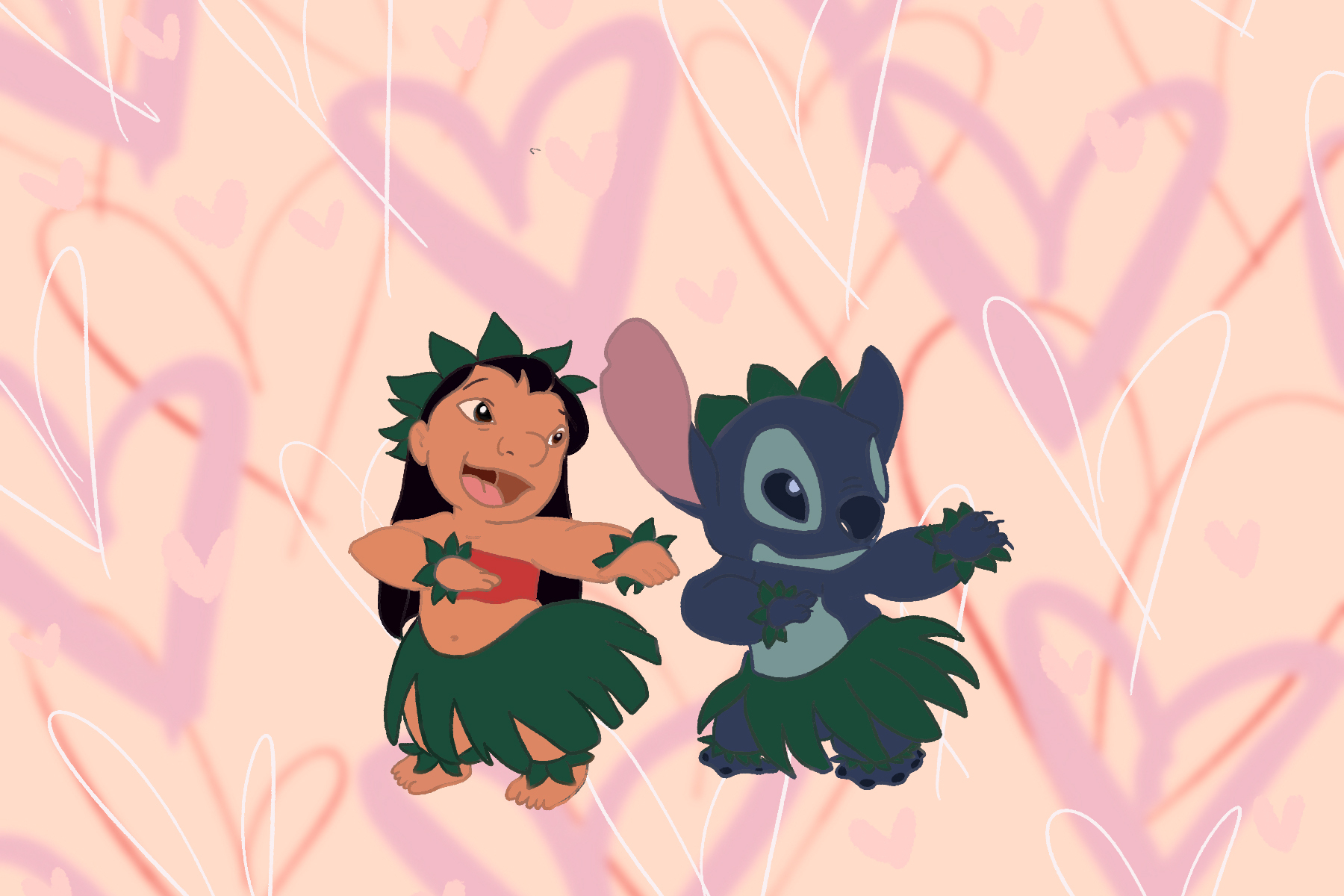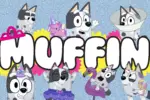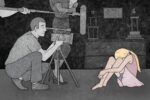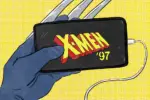For most people, the title “Lilo and Stitch” brings to mind a blue creature with substantially curving ears and a toothy smile. That’s probably about it. The film is considered by many to be a Disney classic, but few can actually recall much about the plot. It even seems that Disney itself uses the franchise mainly as a way to sell Stitch-themed merchandise.
During a recent rewatch, “Lilo and Stitch” surprised me with its emotional depth and meaningful themes, and it earned a spot in my heart as one of my favorite Disney films. This sorely underrated, heartfelt story should be valued for a variety of reasons.
Aesthetics
Before even considering the meat of the story, “Lilo and Stitch” should be celebrated for the visual experience it delivers. The film depicts the Hawaiian island Kauai with stunning watercolor backgrounds. Despite the fact that the use of this technique in animated movies is often considered dated, it was undoubtedly a worthwhile decision.
The watercolor lends to the film a “transparent stained glass-like effect,” according to the movie’s background supervisor. The visuals transport the viewer to the enchanting, lush small town Lilo lives in. The surfing scene, with its fluffy pink-tinged clouds against the cerulean sea is particularly beautiful.
Also integral to the viewing experience is the music. Although “Lilo and Stitch” is not known for its catchy soundtrack like “The Lion King” or “Frozen,” its music enhances the experience. The film is peppered with songs by Lilo’s favorite musician, Elvis, which is fun.
However, it is the music that draws from Hawaiian culture that stands out. “Hawaiian Roller Coaster Ride” complements the lighthearted tone of the scene when Lilo and Nani surf with David after a difficult day of job hunting.
“Aloha Oe,” a beloved Hawaiian song, is heartbreaking as Nani sings it to Lilo, thinking they are going to be separated. I would be lying if I told you my eyes weren’t wet as Nani sang “Until we meet again.”
https://www.youtube.com/watch?v=WraKfeFtOPs
Characters and Relationships
The film is a wild ride about a “monstrosity” of a creature escaping to Earth and being pursued by three aliens — a mad scientist, an Earth environmental expert and a military captain. Yet, the relationships among the characters, not the plot, is what makes the film particularly special.
The characters are not perfect. Instead, they are messy, silly and flawed. They are real and because of that, they are endearing. In creating real characters, the writers deliver genuine, fun dialogue. Lilo’s words are silly and unpredictable but heartfelt, crafted in a way it seems only kids can master. In perhaps one of my favorite lines from the film, she exclaims “Stitch is troubled. He needs dessert!”
Arguably the main relationship in the movie is that of Lilo and her older sister, Nani. Nani is Lilo’s guardian, as their parents passed away. With this relationship, the movie provides representation of a family unit that is less conventional. Of course, there are many Disney movies that include the death of parents, but most do not grapple with how this realistically affects a family unit.
“Lilo and Stitch” feels sincere, as Nani struggles to work, care for Lilo and prove to the social worker Mr. Bubbles that she is an adequate caretaker. Not only does she carry all these responsibilities, but she does so at the age of 19. This seemed old to me when I was younger, but now this young age only makes me feel for and admire Nani more.
Despite struggling to balance responsibilities, her love for Lilo is so evident to the viewer. When Lilo asks if she is the reason why Nani lost her job, Nani pushes aside her own frustration and says “Nah, the manager’s a vampire and wanted me to join his legion of undead.” When the woman working at the shelter where they adopt Stitch tells Lilo “That’s not a real name,” Nani stops her. Nani lets Lilo be who she is, hyperactive imagination and all.
Still, the writers keep their relationship real. Nani and Lilo fight, like all siblings do: “We’re sisters, it’s our job,” Lilo exclaims. Nani struggles to balance the roles of sister and mother while Lilo rebels against her instructions. Nani shows frustration when Lilo sabotages the social worker’s visit, but ultimately is understanding and forgiving. The movie shows how they both struggle with the new structure of their relationship, but there is no lack of love.
Of course, I can’t discuss characters without bringing up David, Nani’s friend. David is a fantastic representation of a caring and kind male character. With movie screens being dominated by hypermasculine and often toxic men, he is not only refreshing, but important.
His kindness toward Nani and Lilo is unwavering. He lifts their spirits by surfing with them after Nani fails to find a job, claiming that “There is no better cure for a sour face than a couple of boards and some choice waves.” David then tries to help Nani find a job. He even brings Lilo, Nani, Stitch and a cache of aliens to shore after their ship lands in the sea — all without missing a beat.
Identity
In addition to providing fantastic characters, “Lilo and Stitch” grapples with an array of important themes, including the concept of identity and who gets to define it. Stitch is seen as 100% evil by the Galactic Federation and his creator, Jumba, who calls him “an abomination” and “a deformed product of a deranged mind.”
Multiple times throughout the movie, Stitch is reduced to this identity by those around him. Jumba believes that Stitch “cannot be taught to ignore his destructive programming” and even tells him that he “can never belong.”
Yet, Stitch becomes — not without some destruction — Lilo’s friend and eventually, a part of her family. This is what happens when he is able to shirk the expectations the other aliens force on him. Thus, the film shows that we do not have to be what other people think we are or should be. We can always grow and change.
Love and Belonging
At its very core, “Lilo and Stitch” is a story about wanting to belong. At the beginning of the film, Lilo does not have friends. The other girls she goes to hula class with make fun of her. Similarly, Stitch, a lab creation, does not have a family.
In one of the most heartbreaking scenes from the movie, Stitch recreates an image from the fairytale “The Ugly Duckling,” which he sees in one of Lilo’s books. He stands in the forest alone, mirroring the duckling’s dialogue, “I’m lost,” and waits for a family to come to him, as they do for the duck. Both Lilo and Stitch feel unlovable.
https://www.youtube.com/watch?v=gDaNrVVPS2k
Yet, through patience and understanding, they find friendship with each other. Despite multiple destructive acts, Lilo is kind and patient with Stitch. She seeks to understand him and asks him about his family: “What happened to yours? I hear you cry at night. Do you dream about them? I know that’s why you wreck things and push me.”
Ultimately, by the end of the film, both Lilo and Stitch find a patchwork family to call their own, with Nani, Mr. Bubbles and the aliens Jumbo and Pleakley. Thus, the movie comments on how belonging can be found where you would least expect it. Furthermore, families can come in all shapes and sizes.
Emotional Impact
Overall, “Lilo and Stitch” left me feeling so much more than just the desire to cuddle a little blue alien. In fact, the wide range of emotions it evoked in me rivals that of any other Disney film I have seen.
Though not necessarily perfect, the film warrants more attention and another watch for those who have not seen it in a while. Those who do revisit it will be surprised by the emotional punch it packs and may find themselves wondering if it is the same film they watched as children.
“Lilo and Stitch” deserves more love, though I can’t say I am on board with the live-action film that is apparently in the works.

















